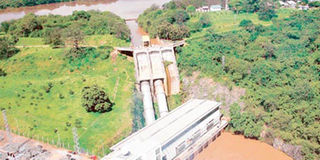Power crisis looms as poor rains lead to low dam levels

The Kindaruma hydro power station in Embu county is one of the Seven Forks dams that produce most of Kenya’s electricity. Photo/FILE
What you need to know:
- Seven Forks hydroelectric power generation dams account for nearly half of the country’s total output.
- The turn of events forced the Ministry of Energy to call for a crisis meeting on Tuesday last week to deliberate on the way forward.
- Uploading of geothermal power could also help avert a possible increase in power tariffs by avoiding the restarting of emergency power to Kenya, which was produced by Aggreko company.
Kenya could be plugged into a power shortage crisis unless the expected long rains fall in time and in adequate amount.
In what continues to be an indictment of the country’s over-reliance on rain, KenGen says the effect of the failure of the short rains — which were both late and depressed — is already being felt, with water dam levels dropping by six metres of their spilling mark.
A review of rainfall performance released by the director of Kenya Meteorological Services, Dr Joseph Mukabana, early this month shows that the October-December 2013 seasonal rainfall was generally poor over several parts of the county.
“The poor rainfall performance during the season resulted in (among others) reduced water levels in the Seven Forks hydroelectric power generation dams,” Mr Mukabana notes.
Seven Forks hydroelectric power generation dams account for nearly half of the country’s total output.
According to the state controlled power generator, KenGen, by Thursday last week the water levels in the Seven Forks dams were at 1050.6 metres, against their spilling levels of 1056.5 metres. The current levels are projected to fall further to 1048 metres by March.
“While it is still safe to generate at these levels, continued generation is pegged on resumption of the long rains in March-April,” KenGen managing director Albert Mugo told Smart Company. “If the rains fail and the dams go below 1036 metres, making generation impossible, a quick-fix solution through emergency diesel generators will have to be procured.”
The turn of events forced the Ministry of Energy to call for a crisis meeting on Tuesday last week to deliberate on the way forward.
The meeting was attended by ministry officials, KenGen, Kenya Power, the Geothermal Development Company, and sector regulator ERC. One of the resolutions reached was to ease power generation from water sources from the Seven Forks cascade should the long March-April rains delay or fail.
“We met on Tuesday and agreed on a programme to use the available water should the long rains delay or be below normal. But forecasts also show that at current levels, we are not badly off,” added Mr Mugo.
However, the Energy Principal Secretary, Mr Joseph Njoroge, is discounting going back to expensive diesel power and is instead pushing for the commissioning of geothermal stations to fill the drop in power supply once hydro generation is scaled down.
“We will live with it. There will be no quick fixes,” said the PS. He also ruled out the possibility of procuring more diesel generators as a quick-fix solution.
This will see KenGen commission additional capacity from the Sh84 billion Olkaria Power plants tomorrow, bringing on board 12.8MW to the national grid.
The commissioning is on a phased programme to be scaled up to 70MW later in March.
“We met the contractors today, who assured us that the first generators using the well-head technology will be up and running next week,” Mr Mugo said in a telephone interview.
Kenya Power official Migwi Theuri said a line to transmit the power to the national grid was completed in December last year.
Uploading of geothermal power could also help avert a possible increase in power tariffs by avoiding the restarting of emergency power to Kenya, which was produced by Aggreko company.
In August this year, the government decommissioned 90 megawatts of emergency power from Aggreko’s generators based in Embakasi, Nairobi, leaving it with only the Muhoroni generator which producers 30MW for the Western region.
Between 2009 and 2010 when the country experienced prolonged drought that lowered water levels at hydro dams, Aggreko was licensed to generate 290 megawatts of electricity.
The Kenya Association of Manufacturers is, however, warning that any power shortage or tariff review could rock the manufacturing sector.
Mr Pradeep Paunrana, vice chairperson of the Kenya Association of Manufacturers (KAM), and also CEO of ARM Cement, said power accounted for up to 75 per cent of production costs for several heavy industries like steel, cement and textile manufacturers.
“Power is a significant component of our bills. Any upward review, arising from a shortfall in hydro, would revert the country to the 2008/09 period when an acute power rationing programme owing to a devastating drought led to the highest power tariffs ever, added Mr Paunrana, who chaired a Government-appointed committee to mitigate the then nationwide crisis.
The current national peak power demand stands at 1,800MW against KenGen’s installed capacity of 1,250MW. This is projected to shoot up three times to 5,400MW in the next five years.
KenGen has ambitious targets to add some 700 units of power within three years through a mix of geothermal, coal and wind sources, along with private generators.
Now the power firm says it is keen to shift the generation mix to include 80 per cent of green energy and bring new coal power on line.
Its other projects are two coal projects near the planned port of Lamu and at Kitui’s Mui Basin area, the grand 280MW geothermal project, and some 100mw of wind power near the border of Meru and Isiolo counties.
The firm has, however, abandoned the 600 megawatt coal plant planned to be fired with imported coal following an outcry from the locals.
“We plan to double the installed capacity and aim for a 40 per cent reduction in the cost of power,” said Mr Mugo.




